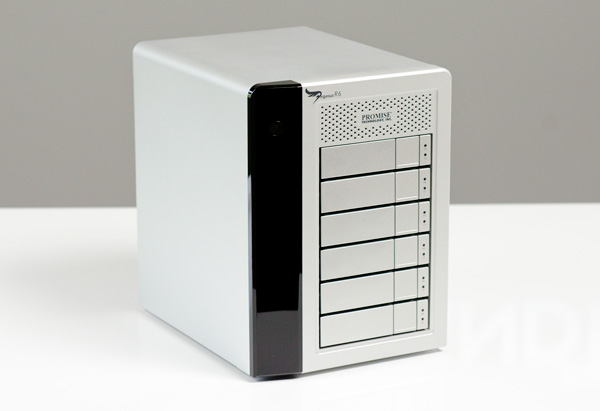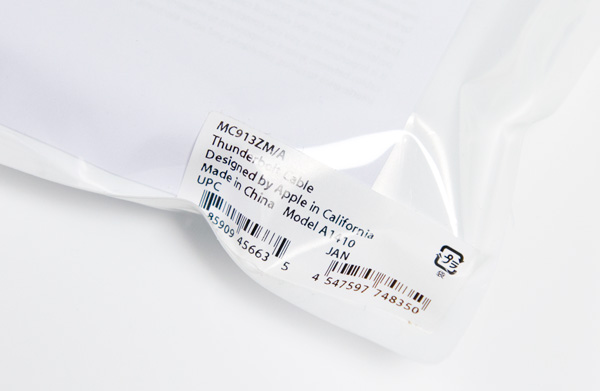Promise Pegasus R6 & Mac Thunderbolt Review
by Anand Lal Shimpi on July 8, 2011 2:01 AM ESTFinal Words
There are really two things that need concluding in this article. We'll start with the Promise Pegasus R6. Without a doubt this is the highest performing external enclosure you can get for your 2011 MacBook Pro or iMac. Even using lowly mechanical hard drives you can get absolutely amazing sequential performance out of the R6. In its beefiest configuration you get 10TB of storage that you can readily access at over 600MB/s. For a MacBook Pro or iMac user that does a lot of HD video work, this amount of high speed storage is just unheard of. The big tower guys have always been able to piece together beefy RAID arrays, but now you're able to get that sort of an experience in a more compact computing device.
I'd love to see Promise offer a version of the Pegasus with SSDs instead of mechanical drives. If Promise didn't want to retool the Pegasus' design it could come in the same chassis, but it'd be really nice to see an even smaller form factor chassis designed exclusively around the 2.5" form factor. I've already shown what four high speed SSDs can do in the R6's chassis. You obviously don't get the capacity but I suspect there's a class of users out there that needs more than what a MacBook Pro can offer with its internal drive bays, but doesn't quite need 10TB of storage.
The Promise Utility that comes with the Pegasus is nice but I found it slightly temperamental at times. I almost feel like we're another couple of software/firmware revisions away from a more polished solution, although admittedly I didn't encounter any issues when I was just using the device as configured.
The biggest drawback to the Pegasus is its price. At $1999 fully loaded, or $999 for an entry level 4TB R4 it's just a very difficult device to justify. I suspect if your work depends on it then you'll have no problems spending the money, but it is a very niche product as a result. I would like to see Promise or someone else offer a barebones Thunderbolt chassis for those users who need this sort of performance but at a better price point. I can understand the price premium for Thunderbolt, but at these prices the technology is simply out of the reach of too many who could honestly use it.
Which brings me to the next topic of discussion: Thunderbolt. The interface is fast, there's no doubt about that. With the right drive configuration I had no problems pushing 8Gbps over the PCIe channel while sending another ~7Gbps over the DisplayPort channel to a 27-inch monitor. It's clear that Thunderbolt has what it takes to really enable more users to migrate from big desktops to high powered quad-core notebooks. The interface effectively solves the high speed local storage issue.
I'd love to see Apple get really aggressive here and offer a Cinema Display with two Thunderbolt ports, more USB ports, Ethernet and audio out. Then MacBook Pro users would only have to run a single Thunderbolt cable + power to their notebooks when they're docked at a desk. I'd also like to see full-speed performance when used in Target Disk Mode. Thunderbolt could become the new defacto way to quickly migrate data between Macs.
I am concerned that we may run into bandwidth limitations in the not too distant future. If we can already push 5 - 8Gbps of data on a single channel, what happens when you run Gigabit Ethernet and USB over Thunderbolt as well. For high end users, I see a definite need for faster signaling or multiple Thunderbolt ports.
I also have concerns about cable costs and widespread adoption. For Thunderbolt to really take off we need to see tons of products that support it. Intel's Thunderbolt controller IC can't be cheap, so I am curious to find out if more companies will give Thunderbolt a try. I believe cable costs can be prohibitive, but today device costs are the bigger concern.
Intel already announced that we'd see Thunderbolt support in Ivy Bridge designs next year so it may be at least one more year before we see just how much market potential Thunderbolt has. While I'm happy that Apple is championing the standard, Thunderbolt really needs widespread industry support to make an impact.












88 Comments
View All Comments
darwinosx - Friday, July 8, 2011 - link
All two or three devices? By end of year there will be a flood of consumer devices with Thunderbolt ports.epobirs - Friday, July 8, 2011 - link
Not if apple remains the sole platform including it. Niche markets can be expensive. Until Thunderbolt is an option in Windows systems the numbers just won't be there for the consumer market. The devices will continue to be expensive for most non-professional Apple users as well, making this a very expensive product category.Consider the premium USB 3.0 is still carrying almost a year after it started being included in shipping systems and widely available as an upgrade via PCI-e board. This past week was the first time I saw a USB 3.0 flash drive priced low enough to be worthwhile. Frys had a 16 GB Corsair unit for $20 after rebate. Note that this unit is almost 50% larger than the USB 2.0 version and so may not be acceptable to all.
Next year, as motherboard chip sets with native USB 3.0 support enter the mainstream the transition should pick up steam. It's taken more than three years since the first controllers became widely available. So try toimagine the glacial growth rate for Thunderbolt outside professional applications if it doesn't get a decent footprint beyond the Mac.
iwod - Friday, July 8, 2011 - link
AOC recently announce a Monitor that can be powered by 2 USB, roughly 9W. Which means it it really did worked out. A Thunderblot version could be possible, having an external monitor with just 1 cable!!!.MobiusStrip - Tuesday, July 12, 2011 - link
And at least Thunderbolt is an appropriate conduit for video, which USB is not.cactusdog - Friday, July 8, 2011 - link
Haha the motherboard makers are gonna run out of space putting all these different connections. Maybe they can retire some like firewire....Anyway, any chance of a review of the Samsung S27A950D 120Hz monitor? Alotta people are interested. Thanks.
xype - Friday, July 8, 2011 - link
Retire FireWire, but leave the VGA, Serial, Parallel ports. That would totally make sense.Exodite - Friday, July 8, 2011 - link
VGA still makes sense, on account to the large numbers of projectors in circulation making use of it.As for the others, not so much.
Anato - Friday, July 8, 2011 - link
Y, but it still could be substituted with Displayport/Thunderbolt and make an adapter for VGA/DVI/HDMI.I hate to see VGA as only option in computers costing 2000€ :(
Exodite - Friday, July 8, 2011 - link
You can already do that.All you have to do is pay through the nose for three adapters (VGA, DVI and HDMI) and carry them with you at all times.
Personally I wouldn't buy a notebook without native VGA output, preferably coupled with HDMI.
repoman27 - Saturday, July 9, 2011 - link
OK, I recognize that most A/V equipment isn’t refreshed as often as PCs are, but the industry started the switch to digital display interfaces 12 years ago. If you really can’t part with your equipment that predates DVI, you can pick up an Apple mini DisplayPort to VGA adapter for $29, or a generic one for $5. It’ll fit in your pocket, and yes it will work with the Thunderbolt equipped Macs. And hey, now that you’ve got an analog signal, it’s no problem to use a passive adapter to convert to s-video or composite video, and then you can attach it right to your RF modulator and drive any TV made since 1941. Complete backwards compatibility for under $15 that will fit in your pocket (although you’ll probably need cargo pants for the RF modulator.)If you can confine yourself to connecting to displays manufactured in the last 10 years or so, you can get an Apple DisplayPort to DVI adapter for $29, or a generic one for $5. It’ll fit in your pocket, and yes it will work with the Thunderbolt equipped Macs. Combine that with a DVI to HDMI cable for an additional $2, and now you can connect to any display with a digital interface except those requiring dual-link DVI. If you want audio as well as video over HDMI, you can get a mini DP to HDMI adapter such as the super slick Griffin GC17096 with Audio and DVI for $27, or go generic for far less.
The only cumbersome and expensive conversion on the newer Macs is when you absolutely have to go the dual-link DVI route. This requires an active adapter that has to regenerate the video signal. The apple version will run you $99 (see, those TB cables aren’t so expensive after all). However, Thunderbolt may actually allow for cheaper and more elegant solutions due to sufficient power being available on the port. Then again, dual-link DVI only displays are cumbersome and expensive in and of themselves, so it shouldn’t matter too much to those who actually own one.
The whole point of Thunderbolt is that it’s NOT yet another connection, it’s a radical extension of the capabilities of one you already have—the video out port. The only digital display interfaces that are even remotely as versatile, capable or compact as mini DP are mini/micro HDMI, but their consumer electronics heritage presents some drawbacks for PC applications. Not to mention that it is the packetized nature of the DisplayPort protocol itself that allows it to be combined with PCIe on a single link to create Thunderbolt. VGA ports are literally 8 times the size of mini DP ports and DVI are larger still. By forcing those who need to connect to 10 year old equipment to carry a $5 adapter in their pockets when they might need to do so, manufacturers are able to give everyone an additional 15 minutes of power when running on battery.